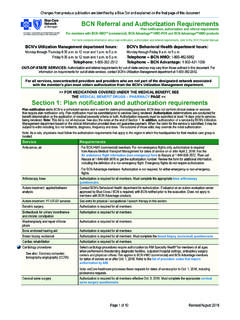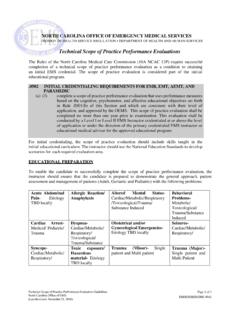Transcription of Chapter 4 Diagnosis of Tuberculosis Disease
1 Chapter 4: Diagnosis of TB Disease75 Chapter 4 Diagnosis of Tuberculosis DiseaseTable of ContentsChapter Objectives .. 75 Introduction .. 77 Medical Evaluation .. 78 Chapter Summary .. 104 References .. 106 Chapter ObjectivesAfter working through this Chapter , you should be able to Describe the five components of a TB medical evaluation; Identify the major components of TB diagnostic microbiology; List at least five symptoms of pulmonary TB Disease ; Explain the purpose and significance of acid-fast bacilli (AFB); Explain the purpose and significance of the culture; and Explain the purpose and significance of 4: Diagnosis of TB Disease76 Chapter 4: Diagnosis of TB Disease77 IntroductionTuberculosis (TB) is not as common as it was many years ago in the United States; consequently, clinicians do not always consider the possibility of TB Disease when evaluating patients who have symptoms. As a result, the Diagnosis of TB Disease may be delayed or even overlooked, and the patient may remain ill and possibly infectious for a prolonged period.
2 Not all persons with TB Disease have symptoms; however, most persons with TB Disease have one or more symptoms that lead them to seek medical care. All persons with symptoms of TB Disease , or either a positive tuberculin skin test (TST) or an interferon-gamma release assay (IGRA) indicative of M. Tuberculosis infection, should be medically evaluated to exclude TB all persons with TB Disease have symptoms; however, most persons with TB Disease have one or more symptoms that lead them to seek medical persons with symptoms of TB Disease , or either a positive TST or IGRA indicative of M. Tuberculosis infection, should be medically evaluated to exclude TB All persons with symptoms of TB Disease , or a positive TST or IGRA result indicating M. Tuberculosis infection, should be medically evaluated to exclude TB Disease . (choose the one best answer)C. Tr u eD. FalseChapter 4: Diagnosis of TB Disease78 Medical EvaluationA complete medical evaluation for TB Disease includes the following five components:1.
3 Medical history2. Physical examination3. Test for M. Tuberculosis infection4. Chest radiograph5. Bacteriologic examination of clinical Medical HistoryWhen conducting a medical history, the clinician should ask if any symptoms of TB Disease are present; if so, for how long, and if there has been known exposure to a person with infectious TB Disease . Equally important is obtaining information on whether or not the person has been diagnosed in the past with latent Tuberculosis infection (LTBI) or TB Disease . Clinicians may also contact the local health department for information on whether a patient has a past history of TB infection or Disease . If the previous treatment regimen for TB Disease was inadequate or if the patient did not adhere to therapy, TB Disease may recur and possibly be drug-resistant. It is important to consider demographic factors ( , country of origin, age, ethnicity, occupation, or racial group) that may increase the patient s risk for being exposed to TB infection (see Chapter 2, Transmission and Pathogenesis of Tuberculosis ).
4 Clinicians should determine if the patient has underlying medical conditions, especially human immunodeficiency virus (HIV) infection or diabetes, that increase the risk for progression to TB Disease in those latently infected with M. Tuberculosis . Clinicians should determine if the patient has underlying medical conditions, especially HIV infection and diabetes, that increase the risk for progression to TB Disease in those latently infected with M. discussed in Chapter 2, Transmission and Pathogenesis of Tuberculosis , TB Disease most commonly affects the lungs and is referred to as pulmonary TB Disease . Pulmonary TB Disease usually causes one or more of the symptoms indicated in Table Disease most commonly affects the lungs and is referred to as pulmonary TB 4: Diagnosis of TB Disease79 Extrapulmonary TB Disease may cause symptoms related to the part of the body that is affected (Table ). For example, TB of the spine may cause back pain; TB of the kidney may cause blood in the urine; TB meningitis may cause headache or confusion.
5 Extrapulmonary TB Disease should be considered in the differential Diagnosis of ill persons who have systemic symptoms and who are at high risk for TB pulmonary and extrapulmonary TB Disease symptoms can be caused by other diseases; however, they should prompt the clinician to consider TB pulmonary and extrapulmonary TB Disease symptoms can be caused by other diseases; however, they should prompt the clinician to consider TB Symptoms of Pulmonary and Extrapulmonary TB DiseaseSymptoms of Pulmonary TB Disease (TB Disease usually causes one or more of the symptoms)Symptoms of Possible Extrapulmonary TB Disease (Depends on the part of the body that is affected by the Disease ) Cough (especially if lasting for 3 weeks or longer) with or without sputum production Coughing up blood (hemoptysis) Chest pain Loss of appetite Unexplained weight loss Night sweats Fever Fatigue TB of the kidney may cause blood in the urine TB meningitis may cause headache or confusion TB of the spine may cause back pain TB of the larynx can cause hoarseness Loss of appetite Unexplained weight loss Night sweats Fever FatigueChapter 4: Diagnosis of TB Disease80 Study QuestionsMatch the patient symptoms with the type of TB.
6 (Choose the one best answer and write the letter for the correct answer on the line next to the question number.) Patient SymptomsType of TB____ Regina has back pain and blood in her urine, unexplained weight loss, fever, fatigue, loss of Maria has a cough, loss of appetite, and unexplained weight loss. She has also been coughing up Pulmonary TBB. Extrapulmonary TB2. Physical ExaminationA physical examination is an essential part of the evaluation of any patient. It cannot be used to confirm or rule out TB Disease , but it can provide valuable information about the patient s overall condition, inform the method of Diagnosis , and reveal other factors that may affect TB Disease treatment, if physical examination is an essential part of the evaluation of any patient. It cannot be used to confirm or rule out TB Disease , but it can provide valuable information about the patient s overall condition, inform the method of Diagnosis , and reveal other factors that may affect TB Disease treatment, if A physical examination can be used to confirm and rule out TB Disease .
7 (circle the one best answer)A. Tr u eB. FalseChapter 4: Diagnosis of TB Disease813. Test for M. Tuberculosis InfectionSelection of the most suitable tests for detection of M. Tuberculosis infection should be based on the reasons and the context for testing, test availability, and overall cost effectiveness of testing. Currently, there are two methods available for the detection of M. Tuberculosis infection in the United States. The tests are: Mantoux tuberculin skin test (TST) (Figure ); and Interferon-gamma release assays (IGRAs)* QuantiFERON-TB Gold In-Tube test (QFT-GIT) (Figure ); T-SPOT .TB test (Figure ).*See Chapter 3, Testing for Tuberculosis Infection and Control Figure Mantoux Tuberculin Skin Test Figure QuantiFERON-TB Gold In-Tube Test (QFT-GIT)Figure T-SPOT .TB TestThese tests help clinicians differentiate people infected with M. Tuberculosis from those uninfected. However, a negative reaction to any of the tests does not exclude the Diagnosis of TB Disease or LTBI (see Chapter 3, Testing for Tuberculosis Infection and Disease ).
8 TST and QFT tests help clinicians differentiate people infected with M. Tuberculosis from those uninfected. However, a negative reaction to any of the tests does NOT exclude the Diagnosis of TB Disease or A negative reaction for a TST or IGRA test excludes a person from having TB Disease .(choose the one best answer)A. Tr u eB. FalseChapter 4: Diagnosis of TB Disease824. Chest RadiographWith pulmonary TB being the most common form of Disease , the chest radiograph is useful for Diagnosis of TB Disease . Chest abnormalities can suggest pulmonary TB Disease (Figure ). A posterior-anterior radiograph of the chest is the standard view used for the detection of TB-related chest abnormalities. In some cases, especially in children, a lateral view may be Chest Radiograph with Lower Lobe CavityIn some instances, a computerized tomography (CT) scan may provide additional information. A CT scan provides more detailed images of parts of the body that cannot easily be seen on a standard chest radiograph; however, CT scans can be substantially more expensive.
9 In pulmonary TB Disease , radiographic abnormalities are often seen in the apical and posterior segments of the upper lobe or in the superior segments of the lower lobe. However, lesions may appear anywhere in the lungs and may differ in size, shape, density, and cavitation, especially in HIV-infected and other immunosuppressed persons. Radiographic abnormalities in children tend to be minimal with a greater likelihood of lymphadenopathy, more easily diagnosed on the lateral nodular and fibrotic lesions may contain slowly multiplying tubercle bacilli and have the potential for progression to TB Disease . Persons who have lesions consistent with findings of old TB Disease on a chest radiograph and have a positive TST reaction or positive IGRA result should be considered high-priority candidates for treatment of LTBI (see Chapter 5, Treatment for Latent Tuberculosis Infection), but only after TB Disease is excluded by obtaining three specimens for AFB smear and culture because old TB cannot be differentiated from active TB Disease based on radiographic appearance alone.
10 Conversely, fully calcified, discrete, nodular lesions without fibrosis likely represent granulomas and pose a lower risk for future progression to TB Disease . Chapter 4: Diagnosis of TB Disease83In HIV-infected persons, pulmonary TB Disease may present with atypical findings or with no lesions seen on the chest radiograph. The radiographic appearance of pulmonary TB Disease in persons infected with HIV might be typical; however, cavitary Disease is less common among such patients. More common chest radiograph findings for HIV-infected persons include infiltrates in any lung zone, mediastinal or hilar adenopathy, or, occasionally, a normal chest radiograph. Typical cavitary lesions are usually observed in patients with higher CD4 counts, and more atypical patterns are observed in patients with lower CD4 counts because cavitation is thought to occur as a result of the immune response to TB organisms. In HIV-infected persons, almost any abnormality on a chest radiograph may be indicative of TB Disease .















